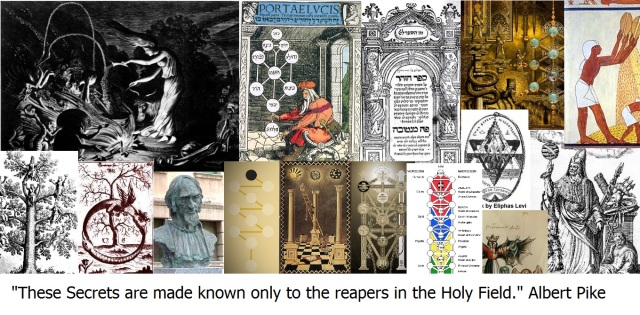
I love this stuff; one secret after another is being revealed. Pike wrote, “These Secrets are made known only to the reapers in the Holy Field.” So I had to ask the question, who were the reapers of the Holy Field? Well, I did a little research and discovered the following, “It is clear from the Zohar that Moses of Leon must have been a member of a society known as the Reapers of the Holy Field. There were many such societies, whose purpose was to pass on the secret, traditional knowledge of the Jews, the Oral Law, which was said to have been given by the Lord to Moses on the mountain. Modern Masons, like ancient Reapers, spend much time memorizing details of the Ancient of Days.” In short, contemporary Freemasons are Reapers of the Holy Field. We are simply following the tradition that Moses of Leon, a Kabbalist from at least the 13th century, wrote about. Once again, enjoy my friends:
Vau, in the tri-literal word, denotes these six members of Microprosopos. For this latter is. formed after the fashion of Macroprosopos, but without Kether, the will, which remains in the first prototype or Universal; though invested with a portion of the Divine Intellectual Power and Capacity. The first Universal does not use the first person, and is called in the third person, הוא, HUA, HE: but the second Universal speaks in the first person, using the word אני ANI, I.
The IDRA RABBA, or Synodus Magna, one of the books of the Sohar, says:
The Eldest of the Eldest [the Absolute Deity] is in Microprosopos. All things are one: all was, all is, all will be: there neither will be, nor is, nor has been, mutation.
But He conformed Himself, by the formings, into a form that contains all forms, in a form which comprehends all genera.
This form is in the likeness of His form; and is not that form but its analogue: wherefore the human form is the form of all above and below, which are included in it: and because it embraces all above and below. The Most Holy so took form, and so Microprosopos was configured. All things are equally one, in each of the two Universals; but in the second His ways are divided, and judgment is on our side, and on the side that looks toward us, also, they differ.
These Secrets are made known only to the reapers in the Holy Field.
The Most Holy Ancient is not called ATHAH, Thou, but Hun, He: but in Microprosopos, where is the beginning of things, He has the name ATHAH, and also AB, Father. From Him is the beginning, and He is called Thou, and is the Father of Fathers. He issues from the Non-Ens; and therefore is beyond cognition.
Wisdom is the Principle of the Universe, and from it thirty-two ways diverge: and in them the law is contained, in twenty-two letters and ten words. Wisdom is the Father of Fathers, and in this Wisdom is found the Beginning and the End: wherefore there is a wisdom in each Universal, one above, the other below.
The Commentary of Rabbi Chajun Vital, on the Siphra de Zeniutha, says: At the beginning of emanation, Microprosopos issued from the Father, and was intermingled with the Mother, under the mysteries of the letter,ה [He], resolved in דו, that is, Daleth and Vau; by which Vau is denoted Microprosopos: because Vau is six, and he is constituted of the six parts that follow Hakemah and Binah. And, according to this conception, the Father is called Father of Fathers, because from Him these Fathers proceed, Benignity, Severity, and Beauty. Microprosopos was then like the letter Vau in the letter He, because He had no head; but when He was now born, three brains were constituted for Him, by the flow of Divine Light from above.
And as the world of restitution [after the vessels of the Sephiroth below Binah had been broken, that from the fragments evil might be created] is instituted after the fashion of the Balance, so also is it formed throughout in the human form. But Malakoth, Regnum, is a complete and separate person, behind Microprosopos, and in conjunction with him, and the two are called man (Albert Pike, Morals and Dogma, 1871, p. 793-794).
Also, if you enjoyed this blog, you might want to take a look at my other blogs, Masonry and the Three Little Pigs and Gnosismasonry, which have a variety of other Masonic topics to discover. Moreover, to get regular updates from this blog, please follow me on Facebook or Twitter. I will accept your friend request if asked.
